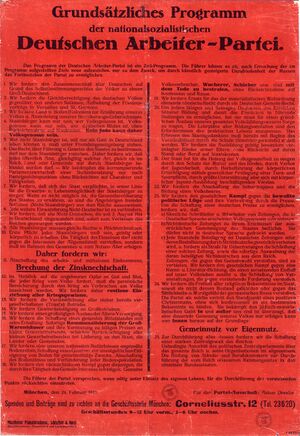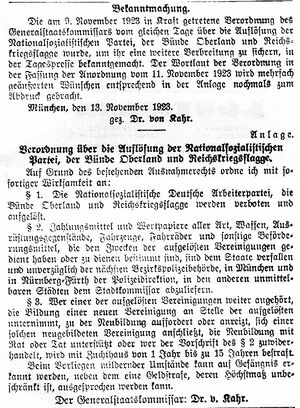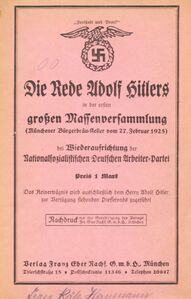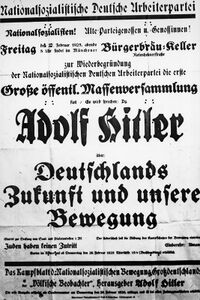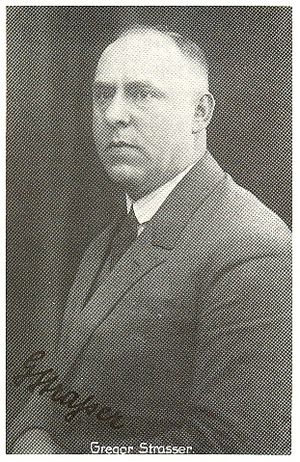EN:Nationalsozialistische Deutsche Arbeiterpartei (NSDAP-National Socialist German Workers‘ Party), 1920-1923/1925-1945
From Historisches Lexikon Bayerns
Party that emerged in Munich from the Deutsche Arbeiterpartei (DAP – German Workers’ Party), from 1921 onward under the chairmanship of Adolf Hitler (1889-1945). The main political characteristics were nationalism, anti-Semitism, a thrust against the democratic parties and a radicalism that that was prepared to resort to massive violence. Banned from 9 November 1923 after the Beer Hall Putsch (Hitlerputsch), the party was reestablished on 27 February 1925; but it was only the increasing economic crisis later on that allowed for the rapid rise of the ever more violent National Socialists. After the seizure of power in 1933, the party and the state became intertwined in many ways. The party's most important remit was now of a propagandistic nature. After the end of the war, the Allies banned the NSDAP on 10 October 1945.
Emergence from the Deutsche Arbeiterpartei (DAP – German Labour Party)
The Deutsche Arbeiterpartei (DAP – German Workers’ Party) was established in Munich on 5 January 1919 on the initiative of Munich toolmaker Anton Drexler (1884-1942). Adolf Hitler (1889-1945) first appeared at one of the meetings in the Sterneckerbräu (Adress: Tal 54, Munich) on 12 September 1919, presumably on behalf of the city commandant's office, and became a member soon after.
On 24 February 1920, he gave a speech at the Munich Hofbräuhaus where he announced the 25 theses for the party`s policy statement In the tradition of the “Alldeutsche“ (All-Germans), it made demands for the unification of all Germans, colonies, strengthening the middle class and discriminatory exceptional laws for Jewish Germans. In many respects it also shared common ground with the ideas in German Socialist circles, which called for the nationalisation of land and money. The ideas of Würzburg economic theorist Gottfried Feder (1883-1941) of Brechung der Zinsknechtschaft (breaking the bondage of interest) were also included in the agenda. At this meeting the DAP was renamed the "Nationalsozialistische Deutsche Arbeiterpartei" (NSDAP – National Socialist German Workers' Party). From the very beginning, Hitler envisioned a party of the masses and not a secret political circle.
In the early days, Hitler deliberately and intensely concentrated on propaganda activities. Thanks to his rhetorical energy, the party was able to hold 46 public rallies, including ten mass rallies, in Munich from the proclamation of the programme to 21 January 1921. Another 35 events followed up to 30 January 1922. 1922 was the party's great year of agitation, when it first started to rise and participated in numerous rallies and meetings of national associations, including the "Deutscher Tag" (German Day) in Coburg.
From the very beginning, the National Socialists used the tactic of appearing as speakers at opposition rallies. They also did not shy away from violent attacks. This aggressive action was initiated by Hitler himself. In January 1922 he was sentenced to three months in prison for his participation in the mistreatment of the Bavarian Particularist engineer Otto Ballerstedt (1887-1934). He served one month in Stadelheim Prison from 24 June to 27 July 1922; the remainder was on parole. Hermann Esser (born in Röhrmoos, Dachau district, 1900-1981) was responsible for organising the propaganda with posters, stickers, pamphlets, speeches and demonstration meetings; in addition, the editor-in-chief of the party's own "Völkischer Beobachter" (People's Observer), Dietrich Eckart (born in Neumarkt/Opf., 1868-1923), his successor Alfred Rosenberg (1893-1946) and Gottfried Feder were particularly active in disseminating the party objectives.
Membership, Financing and Organisation in the Early Days
The party acquired the character of a legal entity with the registration of the "Nationalsozialistischer Deutscher Arbeiterverein e.V." (NSDAV) on 12 October 1920. Until 1 November 1921, the party leadership continued to meet in a rented room at the Sterneckerbräu, after which they rented three rooms at Corneliusstraße 12, which they kept until the party was banned in 1923. The first managing director was Rudolf Schüßler (geb. 1893), formerly a regimental comrade of Hitler as vice sergeant. He was succeeded by Josef Pickl (1868-1951) from 16 November 1921 to 4 January 1922, then by Max Amann (1891-1957) from Munich. From September 1922 his deputy was Philipp Bouhler (1899-1945), also from Munich. As the party flag the swastika flag was used, with which the party supporter and dentist Friedrich Krohn (geb. 1879) had first decorated the lectern when the Starnberg local chapter was founded on 20 May 1920. The swastika symbol had already been common in nationalist circles, such as the Thule Society, in the period before World War I.
At the end of July 1921, there were nine local chapters in Bavaria, at the end of 1922 44 in and 56 outside Bavaria, where the party had been spreading since spring 1922. They all recognised the Munich local chapter as the party leadership. In 1923, the number of local chapters in Bavaria was 178 (Munich and Upper Bavaria 22, Upper Palatinate, Lower Bavaria and Upper Franconia 75, Middle Franconia 22, Lower Franconia 24, Swabia 32, Palatinate 3), outside Bavaria 169. The Munich local chapter was already divided into seven sections in 1921: Lehel, Haidhausen, Neuhausen, Giesing, Schlachthofviertel, Schwabing and Westend.
Further expansion in the Reich was prevented when Prussia banned the NSDAP on 15 November 1922 with the help of the Republikschutzgesetz (Law for the Protection of the Republic). All other states followed suit by the autumn of 1923, except Bavaria. The "Deutschvölkische Freiheitspartei" (German Völkisch Freedom Party), which was stronger in northern Germany, appeared as a substitute and was also banned in Prussia on 23 March 1923. Thuringia, Saxony and Baden followed.
The DAP had 195 members at the turn of the year 1919/1920. In summer 1920, its successor had about 1,700 members, and about 3,000 in 1921. The number of members had risen to about 55,000 by November 1923. In terms of their social background, they were predominantly from the urban lower middle class consisting of minor salaried employees, merchants, craftsmen and lower civil servants. Initially, the large majority came from cities; but after the great increase in 1923, the countryside dominated, in particular rural craftsmen. In addition, about 10% farmers can be identified. Small-town dignitaries, some of whom were Protestant clergymen, were represented among the ruling class in the Franconian region.
The party was financed on the one hand by contributions and donations from members, entrance fees for rallies and the profits from the party's own publishing house Franz Eher Nachf. Verlag, and on the other hand by subsidies from wealthy patrons. Hitler had important personal contacts with the wife of the piano manufacturer Edwin Bechstein (1859-1934), Helene Bechstein (1876-1951), with the publisher Hugo Bruckmann (1863-1941) and his wife Elsa (1865-1946) and from October 1923 with the family of Richard Wagner (1813-1883), in particular with his daughter-in-law Winifred (1897-1980). However, many sources of finance remain unknown.
Orderlies were needed for the party events. As early as November 1920, the watchmaker Emil Maurice (1897-1972), whose Jewish origins were unknown to Hitler, founded a "Gymnastics and Sports Section", which was renamed "Sturmabteilung" (SA – Storm Division) on 5 October 1921. The command and military training was initially provided by retired naval officer Leutnant zur See A. D. Hans Ulrich Klintzsch (born 1898), former member of the "Organisation Consul". At the start of 1923, the pilot Hermann Göring (1893-1946) from Rosenheim took the lead, removed the SA from the influence of the "Organisation Consul" and created a separate high command. The SA was separated from the party in terms of organisation. In addition to the SA, a separate bodyguard unit was created in March 1923, which was renamed "Stoßtrupp Hitler" two months later and was the nucleus of the later "Schutzstaffel" (SS – Protection Squadron). The leaders were the journalist and temporary party treasurer, Josef Berchtold (1897-1962) from Ingolstadt, and Hitler's driver Julius Schreck (1898-1936) from Munich.
Claim for Monopoly in the Nationalist Camp
At that time, Hitler saw himself primarily as a propagandist and not yet as Germany's future leading politician. However, right from the beginning he claimed exclusive power over competing groups from the nationalist camp. In July 1921, Munich's National Socialists negotiated in Augsburg on a union with Otto Dickel's nationalist "Deutsche Werkgemeinschaft" (DW – German Working Community), against Hitler's will. When Drexler did not break off the negotiations, Hitler resigned from the party on 11 July 1921. Since this would have meant the loss of its propagandistic driving force, Drexler capitulated. In the new statutes of 29 July 1921, Hitler was given the party chairmanship with dictatorial powers as a concession for re-joining. On 8 October 1921, Julius Streicher (1885-1946), later editor of the weekly newspaper “Der Stürmer“, also submitted to Hitler's leadership with his local Nuremberg group of the "Deutsch-Sozialistischen Partei" (DSP – German Socialist Party.
The Beer Hall Putsch
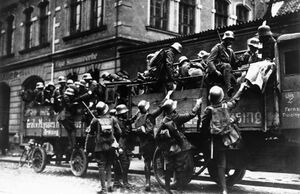
Radicalisation increased when the Reich government under Gustav Stresemann (DVP, 1878-1929) abandoned passive resistance to the French occupation of the Ruhr on 26 September 1923. Ernst Röhm (1887-1934) then succeeded in elevating Hitler as a political leader to the top of the “Deutscher Kampfbund“ (German Militant League), which consisted of the SA, “Reichsflagge“ and “Bund Oberland“. Hitler came under increasing pressure to act in view of his radical demands and the precarious economic situation of his militant supporters. He finally used an assembly organised by State Commissioner Gustav von Kahr (BVP, 1862-1934) on 8 November 1923 in the Munich beer hall “Bürgerbräukeller“ to proclaim the "national revolution". By now at the latest, he claimed the leading political role in Germany. Conservative forces now energetically mobilised state power against the putschists for the first time. The attempted putsch came to a bloody end in front of the Feldherrnhalle when the Bavarian State Police opened fire at noon on 9 November. On the same day, Kahr declared the NSDAP dissolved and its assets confiscated.
The Hitler Trial and the Substitute Organisations for the NSDAP
The trial against Hitler and a number of other putschists, including Erich Ludendorff (1865-1937), took place before the Munich People’s Court from 26 February to 1 April 1924. Hitler was sentenced to five years in the confinement of a fortress but was able to use the trial as a forum for propaganda.
As a substitute body for the NSDAP authorised by him, the "Großdeutsche Volksgemeinschaft" (GVG – Greater German People's Community), which was soon at odds with itself, was created on 1 January 1924 and had its own press organ in the form of the “Großdeutsche Zeitung“. On 7 January 1924, the "Völkischer Block in Bayern" (VBl – Völkisch Block in Bavaria) was formed in Bamberg as a collective organisation of the old-style nationalist forces and an electoral community. Hitler rejected it. Nevertheless, the "Großdeutsche Volksgemeinschaft" ran with the Völkischer Block in the Bavarian state elections on 6 April 1924; together they won 17.1% of the vote.
Reestablishment and Reorganisation of the NSDAP in 1925
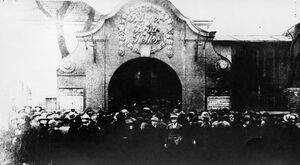
Hitler was released early from Landsberg Prison on 20 December 1924 and the state of emergency was lifted in Bavaria on 16 February 1925. This paved the way for the reestablishment of the party, especially since Hitler had promised the new Minister-President Heinrich Held (BVP, 1868-1938) that he would only act within the framework of the constitution. The plan to expel Hitler had not been feasible because of opposition from Austria.
The founding meeting took place on 27 February 1925 in Munich's Bürgerbräukeller. The state association of the "Völkischer Block", the "Großdeutsche Volksgemeinschaft" and the "Nationalsozialistische Freiheitsbewegung" (National Socialist Freedom Movement) as the joint Reichstag faction of National Socialists and the "Deutschvölkische Freiheitspartei" were disbanded. Ludendorff's political weakness became apparent in the first round of the German presidential elections on 29 March 1925, when he won 3.2% of the vote in Bavaria (1.1% in the Reich). One handicap for a resurgence of the NSDAP in Bavaria was the public-speaking ban on Hitler, which was in effect from 9 March 1925 to 5 March 1927. Although it was possible to rebuild an effective organisation, the party had no political weight in the first few years after it was reestablished.
SDAP poster "Deutschlands Zukunft und unsere Bewegung" ("Germany's future and our movement"). Announcement of a rally in Munich to reestablish the party on 27 February 1925. (Bayerische Staatsbibliothek - Bavarian State Library, Bildarchiv, hoff-6498)
Development up to 1929
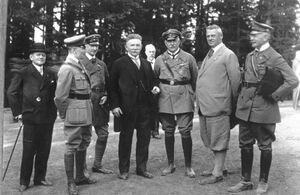
Hitler won the internal party battles, in particular with Otto (born in Windsheim, 1897-1974) and Gregor Straßer (born in Geisenfeld [district of Pfaffenhofen a. d. Ilm], 1892-1934). The "Arbeitsgemeinschaft der nordwestdeutschen Gauleiter" (Working Committee of Northwest German Gau Leaders), founded by Gregor Straßer, never became an opposition that was really a threat to Hitler with its socialist tendencies. Otto Straßer, who advocated the concept of a more radical national socialism, was expelled from the NSDAP in June 1930. Since its reestablishment, Hitler pursued the path of coming to power legally through electoral success. The elections provided an opportunity for intensive propaganda during the free campaign trips; moreover, members of parliament were able to live off their allowances. Their immunity offered welcome protection in the still unrestrained agitation. Between 1924 and 1929, the party concentrated its activities on the cities and neglected the countryside. The result of the elections for the German parliament, the Reichstag, and the Bavarian state parliament, the Landtag, on 20 May 1928 was disappointing (Landtag 6.1%, Reichstag 6.4%) despite the propaganda effort including the use of force and the prominent Reichstag candidate Franz Xaver Ritter von Epp (NSDAP since 1928, previously BVP, 1868-1947). The result was above average in Upper Bavaria with 7.1%, Upper Franconia with 10.8% and Middle Franconia with 9.1%. The percentage in the independent cities was higher than in the countryside. The Reichstag constituency of Franconia took the top spot with 8.1%. The already well organised and consolidated Gaue (regional districts) with intensive propaganda activities were above the Reich average. Bavaria provided three of a total of twelve NSDAP Reichstag members (Epp, Wilhelm Frick [born in Alsenz, Palatinate, 1877-1946] and Gregor Straßer).
The referendum initiated by right-wing conservative forces against the Young Plan, which was intended to regulate the question of reparations to be paid by Germany as the loser of the First World War, once again enabled the party to develop propagandistic activism directed towards a specific goal. However, the referendum on 22 December 1929 only had above-average success in Middle and Upper Franconia. On the whole, the number of votes cast for the German Nationalists and National Socialists did not even match that of the 1928 elections. In the local elections on 8 December 1929, the National Socialists succeeded in gaining seats in 48 out of 59 city councils in independent but only 44 of the 127 non-independent cities. However, they made up just 2% of the elected city and municipal councils. The NSDAP was most strongly represented in towns with between 3,000 and 10,000 inhabitants. The success in Coburg was spectacular, where the NSDAP won an absolute majority on the city council in a city for the first time; in Munich it at least became the third strongest party . The party did not pursue any local politics related to specific issues. Populist proposals that had no chance of success but generated effective propaganda were favoured, as the examples of Munich and Nuremberg show. The alleged model achievements in Coburg, where Franz Schwede (1888-1960) ruled quasidictatorially as mayor since 16 October 1931, consisted of corruption and cronyism in reality. The second Bavarian town where the nationalists obtained the majority on the town council was Neustadt a.d. Aisch in the summer of 1932.
The Elections from 1930 to 1933
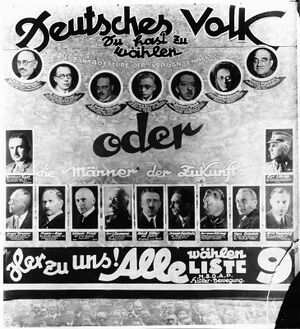
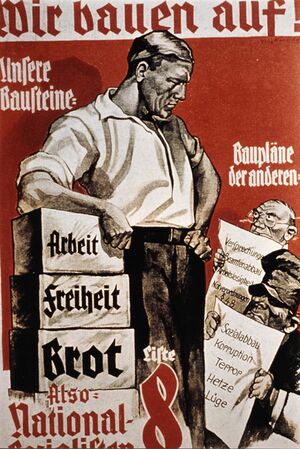
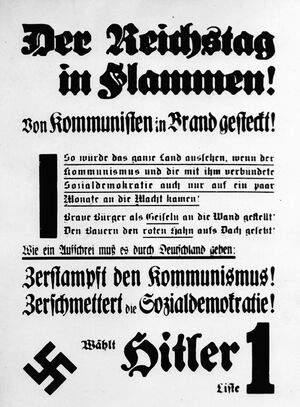
The readiness to use political violence had increased since the autumn of 1929. In Bavaria, the National Socialists could no longer rely on the government's tolerance; surveillance, stricter conditions and bans, such as the ban on uniforms on 5 June 1930, could not stop their success though. Not only did the National Socialist members of the Landtag use their immunity to evade prosecution for numerous offences, they even carried the violent clashes into the Landtag itself, where they repeatedly appeared demonstratively in party uniform during the uniform bans imposed in 1930 and 1932.
The premature dissolution of the Reichstag on 18 July 1930 against the background of the increasing economic crisis presented the National Socialists with a unique opportunity. They now also addressed the previously neglected farmers with their own agricultural programme. In Bavaria they obtained about 18% of the votes (18.3% in the Reich). Strongholds were Middle and Upper Franconia again with about 24% each, with the results in Middle Franconia being balanced in the urban and rural areas while in Upper Franconia they were far above average in the urban areas. Another stronghold was the Palatinate with 22.8%. The urban and rural areas were also equally balanced there. Upper Bavaria was above average with the independent cities, but slightly below average with 17.2% in total. The city of Ingolstadt stood out here with 27.7%. Lower Bavaria was also above average in the cities, in Passau even above 31%, but overall significantly below this figure at 11.6% because of the much lower results in the rural areas. However there, as in Swabia, the NSDAP had dipped into the reservoir of the Bayerischer Bauernbund (BB – Bavarian Peasants' League), whose erosion process continued in the following elections. In the Upper Palatinate (12.4%), the National Socialists only reached the national average in the cities. In Swabia (14.3%), they were lower in urban and rural areas. Lower Franconia trailed at the bottom (12.3%). The party exceeded the national average in the cities there but fell far short of it in the countryside. Obvious were the increases in the Catholic section of the population; the higher voter turnout also benefited the NSDAP. Ten of the party's Reichstag members came from Bavaria. In the German presidential elections in 1932, Hitler won 30.1% of the vote nationwide on 13 March 1932, and 36.8% in the second round on 10 April. The Bavarian result was below the percentage in the Reich. By contrast, the success in the constituency of Franconia was well above average (41.2%). In the Bavarian state elections on 24 April 1932, the party then succeeded in increasing its share to 32.52%. It was thus almost as strong as the "Bayerische Volkspartei" (BVP – Bavarian People's Party) (32,55 %). In particular, the "Bayerische Bauern- und Mittelstandsbund" (Bavarian Peasants’ and Middle Class League) and "Bayerische Landbund" (Bavarian Rural Federation) in Middle Franconia had been routed. Middle Franconia (45.6%), Upper Franconia (44.2%) and the Palatinate (42.9%), where the national liberals had virtually disappeared, were once again far above average. The party achieved record figures in these administrative districts in rural areas with a predominantly Protestant population and agricultural economic structure. In contrast, it by no means scored above average in areas with a high proportion of unemployed. All the other administrative districts were far below average, with the exception of Swabia (30.7%). Lower Franconia remained the "poor relation" in terms of election results and also had the worst organised regional district. In Upper and Lower Bavaria, the Upper Palatinate, Upper and Lower Franconia, the results in the independent cities were higher than the rural areas, in the Palatinate, Middle Franconia and Swabia it was the other way round. However, with this electoral success the NSDAP had also reached its growth limit. In the Reichstag elections in July 1932, it only achieved 32.9% (Reich 37.3%), and in those in November 30.5% (Reich 33.1%). Bavaria provided 21 and 18 National Socialist members of parliament respectively. The party had without a doubt succeeded in breaking into the Catholic camp. In the 1932 July elections, it was slightly stronger than the BVP for the first time. With few exceptions, however, the attitude of the Catholic clergy even in Bavaria remained hostile and distant, unlike that of the clergy of the Protestant Church. Since the state elections in April 1932 and increasingly since November 1932, the NSDAP party whip in the Landtag, Rudolf Buttmann (born in Marktbreit [Kitzingen district], 1885-1947), held talks with the BVP about the participation of the National Socialists in government. BVP chairman Fritz Schäffer (1888-1967) was also working towards a coalition. Buttmann hoped that he could become bavarian Minister-President. However, such a coalition government contradicted the National Socialists’ basic principle of disempowering parliamentarianism. Buttmann was pushed aside by the radicals in the Landtag, including Hermann Esser.
Party Organisation up to 1933
Reichsleitung (Reich Party Directorate)
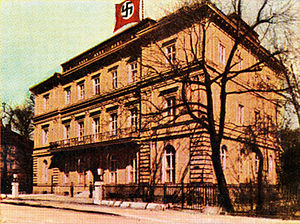
The Reichsleitung (Reich Party Directorate) was formed out of the Munich local chapter. From May 1930 on, the party headquarters was located in the so-called Braune Haus (Brown House) at Briennerstrasse 45 . Before that, it had been in the building of the Franz Eher Publishing House at Thierschstraße 15 and at Schellingstraße 30. The leading positions in the Reichsleitung were called "Amtsleiter" (Office Leader) until 2 June 1933 and then "Reichsleiter" (Reich Leader) afterwards. They were personally appointed by Hitler himself, as were the Gauleiter (Regional District Leaders). The two most important bureaucrats in the Reichsleitung were Philipp Bouhler as "Reichsgeschäftsführer" (Chief of the Chancellery) and "Reichsschatzmeister" (Reich Treasurer) Franz Xaver Schwarz (born in Günzburg, 1875-1947). From 4 August 1925 to April 1926, the "Reichspropagandaleiter" (Reich Propaganda Leader) was Hermann Esser, who was succeeded by Gregor Straßer. In 1928 Hitler headed the office himself, in 1929 it was transferred to the Gauleiter of Berlin, Josef Goebbels (1897-1945). His deputy until 1930 was Heinrich Himmler (1900-1945) from Munich. In 1930, Fritz Reinhardt (1895-1969), long-distance trade school director and financial expert, became Reichspropagandaleiter II. In June 1928, he had founded a school in Herrsching am Ammersee (Starnberg district), which was converted into a training school for party speakers a year later. Straßer was appointed "Reichsorganisationsleiter" (Reich Organisational Leader) as successor to retired Lieutenant General Bruno Heinemann (1858-1938) in December 1927. He was in charge of the Foreign Department, the Press Office and the "Nationalsozialistische Betriebszellenorganisation" (NSBO – National Socialist Factory Cell Organisation), as well as the heads of the offices for Civil Service Issues, Municipal Affairs and War Victims' Support, and the editor of the party's internal newsletter. At his suggestion, a Reichsorganisationsleitung II was established in September 1929 under retired colonel Oberst A.D. Konstantin Hierl (born in Parsberg, 1875-1955), which was to be concerned with the foundations of the future Nazi state, but unlike the Reichsorganisationsleitung under Straßer, it did not have a substructure in the Gaue. The responsibilities were not clearly defined between Straßer and Heinemann. As a precursor to the party court, a three-member enquiry and arbitration committee was set up at the Reichsleitung in 1925, whose chairmen were Heinemann and, from 1927, Walter Buch (1883-1949). The party court had become necessary because of the constant conflicts within the movement. On 1 June 1930, Richard Walther Darré (1895-1953) was given the task of organising the party's Apparatus of Agricultural Policy and was accepted into the Reichsleitung two months later. The dominance of the Munich party headquarters was already waning from 1930 onwards, because Hitler and his closest advisors were spending more and more time in Berlin and other hot spots in order to be as close as possible to political events. The bureaucracy in Munich was continuously expanded nevertheless: most of the party's central offices, divisions and associations were based in Munich. There were 14 main offices in total with numerous subdivisions. The leadership of the "Nationalsozialistische Betriebszellenorganisation", the department for Civil Service Issues and the Foreign Department were not located in Bavaria. Karl Fiehler (1895-1969) and Rudolf Buttmann worked in the Reichsorganisationsleiter’s department as clerks for Municipal Issues, along with Hanns Oberlindober (1896-1949) as clerk for War Victims' Support, Elsbeth Zander (born 1888) as clerk for the "NS-Frauenschaft" (National Socialist Women's League), and the head of the press office, Otto Dietrich (1897-1952). In June 1932, the two heads of the Reichsorganisationsleitung were merged, and the subdivisions were changed several times until Straßer left. Two Reichsinspekteure (Reich inspectors) were appointed, the “Feme“ murderer Paul Gustav Schulz (1898-1960) and Robert Ley (1890-1945), with Main Departments I and II. Main Department III, under Straßer's temporary management, comprised the departments of domestic policy, legal policy, engineering education and public health, with the further subdivisions of "race", public education, military and foreign policy, war victims' support, civil servants, the "Nationalsozialistische Betriebszellenorganisation", foreign countries, Press and women's work; the National Socialist Lawyers', Teachers' and Physicians' Leagues were also under its authority. Main Department IV for Economics was divided into the areas of currency, finance and production, social policy, employment creation, press, archives, propaganda, intergovernmental economic relations and economic sience. Main Department V under Darré, with its own department of forestry, included the offices of horticulture, market and stock exchange, "Ostland", settlement and poultry farming. Before his resignation, Straßer transformed Main Department III into the party's central planning authority. Between the Reichsorganisationsleitung and its Gau associations, Landesinspektionen (state inspectorates) were set up, which covered several Gau regions. Five Landesinspektionen each were under the control of the two Reichsinspektionen (Reich inspectorates). Ley temporarily managed the Bavarian State Inspectorate. In this role he was superior to the Gauleiters, which they perceived as a loss of power and prestige. The greeting by raising the right arm had already been introduced in 1926 based on the fascist model. The greeting "Heil Hitler" had partly already been in use in 1923. The Hitler salute and the title "Mein Führer" were made obligatory in 1932. In December 1932, Straßer's willingness to join the Reich government under Kurt von Schleicher (1882-1934) as Vice Chancellor brought him into irreconcilable opposition to Hitler and he resigned from all party offices on 8 December 1932. The next day Hitler took over the leadership of the Political Organisation himself and appointed Ley as his Chief of Staff. The latter dissolved the Reichs- and Landesinspektionen, as well as the Department of Economic Policy Department. The Apparatus of Agricultural Policy became an independent office reporting directly to Hitler. To create unity, a Central Political Commission was formed under the new Amtsleiter Rudolf Heß (1894-1987), who had previously been Hitler's private secretary. It comprised the Commission for Advice and Monitoring of National Socialist Parliamentary Work in the State Parliaments and Municipalities headed by Buttmann, the Commission for Monitoring the National Socialist Press under "Reichspressechef" (Reich Press Chief) Dietrich and the Commission for Economic Issues with the Sub-Commission for Economic Policy under Walther Funk (1890-1960) and the Sub-Commission for Job Creation under Gottfried Feder. Ley was in charge of the Personnel Office, the Organisational Office and the Political Office as well as the subsidiary organisations "NS-Betriebszellenorganisation", "NS-Frauenschaft", "NS-Beamtenabteilung" (National Socialist Civil Servants Department), "NS-Kriegsopferversorgung" (National Socialist War Victims' Support), the Department of Municipal Policy, the Department of Public Health and the "NS-Ärztebund" (National Socialist Physicians' League). The "Kampfbund des gewerblichen Mittelstandes" (since 7 August 1933 "Nationalsozialistische Handwerks-, Handels- und Gewerbeorganisation" [NS-Hago - National Socialist Craftsmen, Tradesmen and Commercial Organisation]) was newly created under Theodor Adrian von Renteln (1897-1946). Straßer's attempt to limit the Gauleiters' power had therefore failed. Ley did not succeed in building up a comparable position of power within the party apparatus in the period that followed.
After the electoral success of September 1930, the National Socialist party press grew substantially. Before that, the NSDAP only had four daily newspapers in Bavaria ("Völkischer Beobachter", "Donaubote Ingolstadt", "Chiemgaubote Traunstein", "Neue Nationalzeitung Augsburg"), in the Reich as a whole 1; by the end of 1932, there were nine in Bavaria, in the Reich 61 without any regional issues. In Bavaria it accounted for 9% of the total circulation of daily newspapers (compared with 5% in the Reich). The "Nationalsozialistische Parteikorrespondenz" published by Wilhelm Weiß (1892-1950) was issued from 1 January 1932 onwards. Ernst Hanfstaengl (1887-1975), who came from a Munich family of art publishers and had advised Hitler even before 1923 and provided him with important contacts, was appointed the party's foreign press chief after the Reichstag elections in September 1930.
Gaue (Regional Districts) and Gauleiters (Gau Leaders)
At a leaders’ meeting in Rosenheim on 5 July 1925, Hitler announced the formation of a Reichsleitung and at the same time stated that the party would be divided into Bezirke (regions), Gaue and Ortsgruppen (local chapters). However, the Reichsleitung was initially directly responsible for the party organisation throughout Bavaria from 1925 until autumn 1928. One exception were the three Gau districts of Lower Bavaria-Upper Palatinate, Franconia and Rhenish Palatinate as intermediate bodies. There were another 21 Gaue outside Bavaria. The Gauleiters had an increasingly strong position and their own room for manoeuvre within their Gau. They were responsible for the organisation, finances and propaganda. After some restructuring, the 6 final NSDAP Gau districts emerged by 1933: Munich-Upper Bavaria, Franconia, Lower Franconia (from 1935 Main-Franconia), Bayerische Ostmark (Bavarian Eastern March; from 1942 Bayreuth), Swabia and Rhenish Palatinate (Palatinate-Saar, Saar-Palatinate, from 1940 Westmark).
Kreise and Bezirke (Sub-Districts)
In the course of the party's organisational reform initiated by Gregor Straßer in autumn 1928, the Ortsgruppen were combined systematically under the Gau administrations. For the first time, there was also talk of Kreise (and more often Bezirke) as intermediary authorities, which were to be aligned with the Reichstag constituencies. Between the Gau administration and Ortsgruppen there were 28 Bezirke throughout Bavaria from October 1930 onwards; there were four in Munich. They were merely an auxiliary office for the Gauleiter and strictly bound by their instructions. On 10 June 1932, Straßer issued a decree on the comprehensive vertical division of the party. According to this, the Gaue were finally divided into Kreise, which corresponded to the Bezirksämter (from 1939 on Landratsämter - district offices) in Bavaria. This organisational structure was intended to document the strong growth in membership better, improve propaganda and exercise more control over the Gauleiters, but this did not succeed in light of their desire for independence. The newly appointed Kreisleiter (Kreis Leaders) were to complete a training course at a Landesführerschule (State Leadership School). In Bavaria, the Landesführerschule 3 was opened on 17 June 1933 at Plassenburg Castle near Kulmbach.
Ortsgruppen (Local Chapters)
In the autumn of 1929, the eight sections of the Munich Ortsgruppe were declared to be Ortsgruppen in their own right. In January 1930 there were nine, which in turn were divided into 24 sections. In autumn of the same year, there were already 25 Ortsgruppen in Munich, and by 1933 there were 39. The officials of the Gauleitung were combined in a "Gauleitung Section". All Ortsgruppen reported directly to the Gauleitung. In general, an Ortsgruppe should include up to 500 members. Its subunit was a Zelle (cell). In addition to the Ortsgruppen, there were smaller Stützpunkte (bases), which were mostly set up in the countryside and whose members were dispersed. The party leadership in Munich demanded regular reports from the Ortsgruppen in order to ensure extensive monitoring. The number of Ortsgruppen and Stützpunkte throughout Bavaria in 1925 was 139 (Munich and Upper Bavaria 16, Upper Palatinate, Lower Bavaria and Upper Franconia 57, Middle Franconia 18, Lower Franconia 13, Swabia 16, Palatinate 19; Reich in total 607) and in 1928 300 (Munich and Upper Bavaria 32, Upper Palatinate, Lower Bavaria and Upper Franconia 115, Middle Franconia 36, Lower Franconia 21, Swabia 35, Palatinate 61; Reich in total 1,378). In 1930, there were 776 in total (Munich and Upper Bavaria 131, Upper Palatinate, Lower Bavaria and Upper Franconia 246, Middle Franconia 81, Lower Franconia 53, Swabia 130 and the Palatinate 135; Reich 4,964), in 1932 the number in Bavaria was 1,264 (Munich and Upper Bavaria 196, Upper Palatinate, Lower Bavaria and Upper Franconia 246, Middle Franconia 198, Lower Franconia 115, Swabia 285 and Palatinate 224; Reich 11,845). Bavaria's dominance faded with the party's increasing success throughout Germany. In 1925, 50% of all Ortsgruppen were still in Bavaria, in 1932 only 11%.
Membership Development 1925-1933
At the beginning of 1925, all old party membership cards were declared invalid. The number of party members who had joined the party before 14 September 1930 and were still in the party in 1935 was 20,629 in Bavaria (= 15.9% of the members in the Reich). Munich and Upper Bavaria accounted for 4,828 (= 23.4% of the Bavarian members). Over two thirds of these in turn came from Munich. In 1929, the Gau Middle Franconia had about 2,700 members; by the end of 1930 and mid-1932, the number had doubled in each case (membership in November 1932: 13,347). Upper Franconia doubled its membership in 1931. Before the "seizure of power", the number of party members in Bavaria who were still in the NSDAP afterwards, amounted to a total of 85,644 (= roughly 10.1 % of the total number of members in the Reich). This was a more than four-fold increase. With 19,000, Munich and Upper Bavaria had 22.4% of the Bavarian members. In relation to the proportion of the total population, the Gau Franconia was at the top; Lower Franconia came last. 13% of the members were women (in the Reich just 5.5%); about 45% of the female members were resident in the Gau Munich-Upper Bavaria. Fluctuation was very high. At the beginning of 1932, half of the more than 10,000 new members of 1931 in the Gau Munich-Upper Bavaria had already left again. In the period before the September elections in 1930, 26% of the Bavarian members were blue-collar workers. This corresponded to the Reich average. The proportion of blue-collar workers was above average in the Bayerische Ostmark, Middle Franconia, the Palatinate and Swabia. White-collar employees accounted for 20.4% and the self-employed for 21.8% (of which 46.1% belonged to the craft sector, 38.3% to the commercial sector and 15.6% to the liberal professions). Civil servants were represented by 12.9%, of which 20.9% were teachers (nationwide the percentage of civil servants was 7.7%). What was striking in the agricultural state of Bavaria was the far below-average proportion of farmers at 7.1%. Their percentage was almost double at Reich level. Up until 14 September 1930, 4% of the members in Bavaria were unemployed, and 4.6% in the Reich. The middle-class nature of the party was unmistakable, with the lower middle class dominating. The ever-increasing activism in meetings and propaganda marches made the party increasingly attractive to young people. Up until the "seizure of power", the share of blue-collar workers rose to 32.4%, that of white-collar workers fell to 17.4%, that of the self-employed to 16.1% and that of civil servants to 9.1% (still higher than in the Reich). The share of farmers rose slightly to 9.7% (still lower than in the Reich). Middle Franconia had the highest share of blue-collar workers. The proportion of working class among the members in Middle Franconia had already been above average from 1930 onwards, to which the SA's anti-capitalist propaganda had probably contributed a great deal. The party's middle-class character was preserved, although the share of the corresponding occupational groups declined overall. The unemployed were just a small group with 5.5%, despite the economic crisis. 32.3% of party members (in the Reich 36.4%) were aged between 21 and 30 in 1930, and as many as 41.4% in 1933 (Reich 40.4%). The proportion of young people among party members was extraordinarily high in both the Reich and Bavaria. Before the September elections in 1930, 28.6% (5,893) of the party members in Bavaria who were still members of the party in 1935 held the position of a Politischer Leiter (Political Leader, i. e. a leading functionary on any level of the party organisation). This corresponded almost exactly to the share at Reich level. 19% of them were blue-collar workers, 21.5% white-collar workers, 23.2% self-employed, 19.4% civil servants (including 28.3% teachers) and 9.2% farmers. Compared to the membership structure, blue-collar workers (26% of the members) were significantly underrepresented here. By the time of the "seizure of power", the number of officials in Bavaria had risen to 19,981 (23.3% of the members), i.e. it had not quite kept pace with the growth in membership.
Affiliated NSDAP Organisations and Associations
The Sturmabteilung (SA) which had been banned after the Beer Hall Putsch, lived on from August 1924 on in the so-called "Frontbann" under Munich-born Ernst Röhm and soon had about 30,000 followers. With the refoundation of the NSDAP in 1925, the SA was also reestablished, after Röhm's resignation from 1 November 1926 on under the leadership of Franz Pfeffer von Salomon (1888-1968), and after 5 January 1931 under Röhm again. The Nationalsozialistische Kraftfahrerkorps (NSKK – National Socialist Motorist Corps) was created on 20 April 1931 out of the “Nationalsozialistische Automobilkorps” (National Socialist Automobile Corps) that had been formed one year earlier. The "Schutzstaffel" (SS) established by former member of ”Stoßtrupp Hitler” Julius Schreck, existed since April 1925 and was supposed to provide personal protection for Hitler and other party leaders. It was subordinated to the SA leadership in 1926 and was only separated from it again at the end of 1930. As early as 1925, the "Nationalsozialistische Deutsche Studentenbund" (NSDStB – National Socialist German Students' League)) was established in Munich. Wilhelm Tempel (1905-1983) in Leipzig, who was replaced by Baldur von Schirach (1907-1974) in July 1928, who changed the NSDStB’s pseudo-socialist orientation. On 26 June 1931, the league mounted a violent protest during a lecture by Hans Nawiasky (1880-1961), professor of constitutional law in Munich. The first leader of the National Socialist youth movement, which already existed before 1923, was Gustav Adolf Lenk (1903-1987) from Munich, followed by the leader of the so-called "Schill-Jugend" (Schill Youth), Edmund Heines (1897-1934) of Munich. The Hitlerjugend (HJ – Hitler Youth)), which was subordinate to the SA, was created on 4 July 1926, and the "Nationalsozialistische Schülerbund" (National Socialist Pupils' League), which was led by Theodor Adrian von Renteln, at the end of 1929. In 1928 Hans Frank (1900-1946) founded the "Bund Nationalsozialistischer Deutscher Juristen" (League of National Socialist German Lawyers; from 1936 "Nationalsozialistischer Rechtswahrerbund" – National Socialist Legal Preservation League); on the initiative of Hans Schemm (1891-1935) from Bayreuth, the "Nationalsozialistische Lehrerbund" (NSLB – National Socialist Teachers' League)). was founded in his home town in 1929. At the fourth Reich Party Congress in Nuremberg in 1929, the "Nationalsozialistischer Deutscher Ärztebund" (National Socialist German Physicians' League) was launched under Sanitätsrat (Counsellor of Health) Ludwig Liebl (1875-1940) from Ingolstadt. Alfred Rosenberg (1893-1946), editor-in-chief of the „Völkischer Beobachter“, founded the "Nationalsozialistische wissenschaftliche Gesellschaft" (National Socialist Scientific Society) in August 1927. After its dissolution, a new foundation was established in May 1928, the "Kampfbund für Deutsche Kultur" (Militant League for German Culture) based in Munich, which attacked modern art. The "Nationalsozialistische Betriebszellenorganisation" (NSBO), which was intended to exert political influence in factories, was founded in 1928 outside Bavaria, on the initiative of party circles still active in Northern Germany with a stronger emphasis on the socialist component. The Gaubetriebszellenleiter (Gau Factory Cell Leader) for Munich-Upper Bavaria and, from 1932, chairman in Bavaria was Kurt Frey (1902-1945). In September 1932, the number of members was about 25,000 in Bavaria and about 200,000 in the whole of the Reich. Elsbeth Zander had already founded the German Women's Order "Rotes Hakenkreuz" (Red Swastika) in Berlin in September 1923. As of 1 October 1931, it was subordinated to the Reichsorganisationsleitung as the "NS-Frauenschaft" (NSF). In April 1932, the "NS-Volkswohlfahrt" (NSV – National Socialist League for Public Welfare) was founded on the initiative of Alarich Seidler (1897-1979).
The Reichstag Elections on 5 March 1933
During the Reichstag election campaign after the National Socialists took power, the general conditions for the NSDAP were more favourable than ever before. The Bavarian state government could not afford to restrict its activities by banning meetings, propaganda marches and fund-raisers. An emergency decree on 4 February 1933 allowed the Reich government to demand press bans. The Bavarian government complied with this anxiously, even though the BVP newspapers were affected. As recently as during the election campaign of June 1932, Bavarian radio had not broadcast National Socialist speeches; now it was at their disposal. The seizure of power in the Reich also strengthened the party's creditworthiness. Crises and a sense of weariness with regard to conflicts made the slogans of national unity and "Volksgemeinschaft" (People’s Community) and the promise of eliminating unemployment seem very attractive. The party now also had the "chancellor bonus". In addition, Cardinal Michael von Faulhaber (1869-1952) had written an extremely emphatic reminder of the duty to obey authority in a pastoral letter dated 10 February 1933. With 43.1%, the NSDAP beat the BVP by 15.9% in the Reichstag elections on 5 March 1933. If you take into account the administrative districts' independent cities, the NSDAP was at the top in Upper Franconia (49.3%), followed by Middle Franconia (43.1%). It was below average in Upper Bavaria (37.7%), Lower Bavaria (38%), Upper Palatinate (30.8%), the Palatinate (41.7%), Lower Franconia (34.7%) and Swabia (35.7%). In the countryside and in small towns, it took the lead in Middle Franconia (63.7%), followed by Swabia (50.8%), the Palatinate (49.2%), Upper Franconia (48.5%) and Lower Bavaria (44.9%); in the corresponding areas of Upper Bavaria (39.9%), the Upper Palatinate (35.1%) and Lower Franconia (33.5%), the result was below average. Among the administrative districts as a whole, Middle Franconia (51.6%) led ahead of Upper Franconia (48.7%), the Palatinate (46.5%), Swabia (45.5%) and Lower Bavaria (44%). The results were below average in Upper Bavaria (38.8%), the Upper Palatinate (34%) and Lower Franconia (33.9%). But the party even grew in the traditionally Catholic regions of Lower Franconia and the Eichstätt and Bamberg districts. 30 NSDAP delegates came from Bavaria, including Hitler himself.
For the first time, the National Socialists had succeeded in making major incursions into the Catholic-dominated regions of Upper and Lower Bavaria. The gains may have been due primarily to the erosion of the Bayerischer Bauernbund, but it seems that the National Socialists had even succeeded in drawing voters over to them from the Communists. In the Reichstag elections of 6 November 1932 the voter turnout had been 77.7%, in those of 5 March 1933 it had risen to 88%. This is also likely to have contributed to the National Socialists' above-average growth. Hitler's accession to power in the Reich also changed the political conditions in Bavaria. On 9 March 1933, Reichsinnenminister (Reich Minister of the Interior) Wilhelm Frick appointed Franz von Epp from Munich as Reichskommissar (Reich Commissioner) in Bavaria against Minister-President Heinrich Held's protests. Talks with the BVP about a possible coalition, as late as 13 and 19 March 1933, remained fruitless. With the beginning of the NSDAP's tyranny, 5,000 political opponents were already arrested in Bavaria by the end of March 1933. The number of permanent prisoners was around 4,000 between July and December 1933. Bavaria was therefore far above the national average. Between 2,200 and 2,600 of them were imprisoned at Dachau concentration camp. The first "Gleichschaltungsgesetz" (co-ordination law) of 31 March 1933 made it possible to reconstitute the state and local parliaments according to the results of the Reichstag election, with the votes for the communists not counted. A Bavarian enabling act dated 29 April 1933, passed with the help of the BVP against the SPD's votes, gave the Bavarian government the opportunity to encroach on the state constitution. Following the elimination of the other parties by July 1933, the Landtag and Reichsrat were dissolved at the start of 1934.
In the cities of Munich, Augsburg, Regensburg, Nuremberg and Würzburg, the mayors were replaced immediately after the National Socialists assumed power. In the small rural towns and villages, some of the changes were forced, but in many cases the previous mayors adapted and remained in office. In 1935, 65.1% of Lord Mayors, but only 12,4% of those in rural communities had already been party members before 30 January 1933.
The NSDAP, Public Service and Civil Service
By and large, the previous civil service remained in office under the Law on the Restoration of the Professional Civil Service of 7 April 1933. The NSDAP did not have enough qualified personnel, even at the lower levels, to fill all public service positions. In March 1933, only 17 Bavarian "Bezirksamtsleiters" (District Office Leaders) were relieved of their duties by the acting Minister of the Interior Adolf Wagner (1890-1944). In Lower Franconia, 11 out of 22 were replaced in the course of the year. In 1935, 28.4% of them were old party members, 34% new members and 37.2% non-members. In 1935, 65.4% of the Landräte (district administrators) were not party members in the Gau Munich-Upper Bavaria, 84.7% in the Bayerische Ostmark region and 90.5% in Swabia. Of the party members who became heads of state offices in Munich-Upper Bavaria, 96.2% had only joined the party after it came to power, in municipal offices 83% (Bayerische Ostmark: 96.6% and 85.3% respectively). Dismissals for political reasons were also kept within limits in the cities. This mainly affected urban blue-collar workers, who were organised as communists or social democrats. In Munich, 1% of civil servants were dismissed, compared to 3.4% of blue-collar workers. The German Civil Service Act of 1937 made the appointment as a civil servant dependent on prior assessment by the NSDAP. A training camp for ministry officials was established in Tutzing (Starnberg district), but the teaching staff was insufficiently qualified. In the course of the last great wave of admittances to the party (1937), pressure was exerted especially on civil servants to join, which the majority acquiesced to without bringing the desired attitude with them. That vacant posts were filled with old party members therefore tended to be an exception. The successors were professionally qualified, but usually not committed National Socialists. It was not until the late 1930s that representatives of a younger, more activist generation, who had already belonged to the party before 1933, took over. But since they were often drafted into the Wehrmacht, older party members continued to dominate. The attempt to create an ideologically convinced civil service had failed. Nor did the NSDAP succeed in gaining complete control over the apparatus of presidents of the regional governments and Landratsämter.
Party Organisation after 1933
Reichsleitung
The focal point of the party headquarters had already been in Berlin since 1930, and even though the Munich apparatus remained in place, it lost a considerable part to Berlin until 1937. By then, the central institutions were distributed more or less equally between the two cities. The most important party institutions in terms of domestic politics were all in Berlin; the party's central administrative offices, such as the actual office of the "Stellvertreter des Führers" (Deputy to the Führer), the Reichsorganisationsleiter and the Reichsschatzmeister. Furthermore, the Supreme Party Court (Buch), the Reich Legal Office (Frank), which existed until 1942, the Reich Propaganda Office (Goebbels), the Reich Department for Food and Agriculture (Darré), the Department for Colonial Policy (Epp) and the NSKK (Adolf Hühnlein [1881-1942]), remained in the Bavarian capital. Of the main offices, those for Municipal Policy (Fiehler), for War Victims (Oberlindober), for Public Health (Leonardo Conti [1900-1945]), for Civil Servants (also relocated to Berlin later) and for Technology (Fritz Todt [1891-1942]) angesiedelt, ferner die Hauptämter für die "Nationalsozialistische Betriebszellenorganisation" (Claus Selzner [1899-1944]) were still based in Munich, as well as the main offices for the "Nationalsozialistische Betriebszellenorganisation" (Claus Selzner [1899-1944]) and for Trade and Craftsmanship (von Renteln). The respective heads of the Reichsleitung's corresponding offices were at the same time leaders of National Socialist organisations and associations. The Main Office for Education and the NSLB (Schemm, then Wächtler) were still in Bayreuth. The "Nationalsozialistische Deutsche Studentenbund" (Gustav Adolf Scheel [1907-1979]) were also based in Munich. (Walter Schultze [1894-1979]). The Munich apparatus had also increased considerably by 1937. The registration and administration of the membership created so much bureaucracy for the party apparatus that the two new administrative buildings on Arcisstrasse became necessary in 1937. The construction of a party forum in Munich could not be carried out. In 1933, Hitler moved his private office to Berlin as the Parteikanzlei (Chancellery of the Party), as well as the NSDAP Reich Press Office, which was under his personal control. In Berlin, a liaison office was set up under Rudolf Heß for contacts between the Munich party leadership and the Berlin Reich authorities. At the instigation of Heß’s Deputy Martin Bormann (1900-1945), a housing estate was built specifically for Parteikanzlei employees from 1936 on in Pullach near Munich on the future site of the Bundesnachrichtendienstes (BND – Federal Intelligence Service)). This was called the "Reichssiedlung Rudolf Heß". The staff of his office in the Braune Haus still comprised 100 people in May 1939; under his successor Martin Bormann it grew from 200 in 1941 to 400 in 1944.
The head of the party's Political Organisation, Robert Ley, became the Reichsorganisationsleiter in 1934 and took on an additional office in Berlin, where the mass organisations "Deutsche Arbeitsfront" (DAF – German Labour Front) and "NS-Organisation Kraft durch Freude" (KdF – Strength through Joy) under him were located. Ley was also responsible for training in the party. The party elite was to be trained at the training castles ("Ordensburgen") built since 1934. In Bavaria, the Ordensburg was established in Sonthofen (Allgäu region) in May 1935. Qualified personnel did not emerge from it. Unlike at the "Adolf Hitler Schools" (AHS), which Ley had also initiated together with the Reichsjugendführer (Reich Youth Leader) von Schirach, it was not possible to obtain a university entrance qualification there. The "Adolf Hitler Schools" were renamed "Reich Schools" in 1941 – a term that until then had only been used to describe the school that had existed in Feldafing (Starnberg district), which was subordinate to the "Stellvertreter des Führers" and had originally been an SA cadet school. Also not subordinate to Heß was Reichsschatzmeister Franz Xaver Schwarz in Munich as the general representative for the party's property matters. Thanks to his access to its finances, he had a key position in the background. Max Amann also had a great deal of funds at his disposal thanks to the income from the Eher-Verlag publishing house. Moreover, he managed Hitler's private assets. While 1,598 people were employed in the Reichsleitung in 1934 and 2,546 at the end of 1936, one year later there were already 3,172, in 1938 4,449 and in 1942 as many as 5,802. In 1938, 57.1% of this staff worked for the Reichsschatzmeister. In 1940 the Reichsleitung's turnover exceeded the billion mark. In 1942, their costs were estimated at almost RM 100 million; the operating revenues had increased from RM 25,282,000 in 1934 to RM 188,546,000 in 1939. Around RM 76 million was recorded as profit in 1939. In 1939, the value of the real-estate property owned by the Reichsleitung amounted to RM 40 million, of which RM 18,245,000 was in Munich. The Reichsleitung's assets amounted to RM 8.7 million in 1933, and to RM 170 million in 1939.
Gaue and Gauleiters
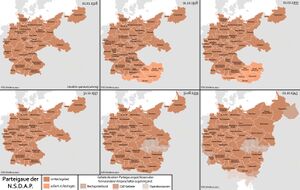
The Gauleiters, in addition to the "Stellvertreter des Führers", the Reichsleiters and the leaders of the party's subsidiary organisations and associations, were entitled to propose candidates for the coveted Reichstag mandates. Reich Minister of the Interior Frick had the last word in the selection process as Reichswahlleiter (Reich Election Commissioner). For the prestige of the Gauleiters it was obviously important not to be short-changed when it came to the distribution of the mandates. After the Reichstag elections in 1936, for example, Wächtler complained to Frick that the Bayerische Ostmark had been put at a disadvantage relative to the Gaue Middle Franconia and Main-Franconia. The Gauleiters exerted an important influence on the filling of important positions by issuing political references. As representatives in their area, they largely pushed the presidents of the regional governments into the background, unless they exercised this office themselves. From 1942 onwards, the Gauleiters became increasingly important in their position at the expense of the Reich ministries. As early as 1940, they were Gau Housing Commissioners (the Reich Housing Commissioner was Robert Ley), and in 1942, they were not only Reich Defence Commissioners (with access to new administrations such as armament commissions and economic offices), but also Gau Commissioners for Labour Deployment. The more the war situation deteriorated, the more power Hitler gave the party offices at the expense of the state authorities. From 13 July 1944 on, the Gauleiters could issue instructions to the state authorities and request the deployment of police forces. On 20 September 1944, Hitler withdrew the supreme executive authority from the military commanders and transferred it to the Gauleiters. They were also responsible for the Volkssturm (home guard).
Kreisleiters
After the "seizure of power", the Kreis administrations' range of tasks also expanded considerably. The constant propaganda to influence popular opinion and mood was one of their most important tasks. They acted as political supervisory bodies towards the respective Bezirksamtsleiters. They also intervened in the administrative area of the state and municipalities. They had the last word in filling mayoral posts. At the beginning of 1935, 13 of the 23 Kreisleiters in Munich-Upper Bavaria were simultaneously municipal leaders, in the Bayerische Ostmark 24 of 47, in Franconia 8 of 16, in Main-Franconia 7 of 21, in Swabia 6 of 23 and in the Palatinate 4 of 14. The high number of offices held concurrently was repugnant to party leadership and state authorities in the long run, which is why the party leadership demanded their termination on 19 February 1937 for the same year. However, this was not fully realised: in 1942, a quarter of the Kreisleiters still held such an office. The intensified expansion of personnel in the Kreis administrations since 1936 generated additional costs. When the party was reopened for the admission of new members in 1937, it received new funds, which were, however, partly eaten up by the greater administrative burden. State funding was discarded in order to not make the party dependent on the authorities. Some Kreisleiters also ran secret accounts, but the Reichsschatzmeister intervened against this. One way of financing the Kreisleiters themselves was by means of a parliamentary mandate in the Reichstag. 25 of the 162 Kreisleiters in Bavaria had a Reichstag mandate. Not all of them were full-time functionaries, in fact still only the minority in 1936. However, in 1937, Rudolf Hess ordered that the Kreisleiters, with the exception of freelancers and farmers, should be professional functionaries, so the ratio was gradually reversed. The number of Kreise in Bavaria was 141 on 1 January 1935, and just 104 on 1 December 1940. The reason for the reduction was financial. The average number of functionaries under a Kreisleiter in Bavaria in 1935 was 170, in 1940 it was about 500. Most Kreisleiters came from a well-established social background and did not need party status for their professional careers. Most of them came from the financially better-off middle class. 50% of them were younger than 40 in 1935. The fluctuation in office was very high, in contrast to the Gauleiters. All Bavarian Kreisleiters had already joined the party before the "seizure of power", 79% before the election success of September 1930, whereas only 32.5% of the leaders of Ortsgruppen had done so. As with the Gauleiters, the Kreisleiters' range of tasks and areas of responsibility expanded considerably during the war.
Ortsgruppen and Stützpunkte
The Ortsgruppen were the direct framework for the involvement of local party supporters; at the same time, they provided for the indoctrination and monitoring of the entire population. Their apparatus was also expanded over time. The Ortsgruppen also took on social tasks by offering support services such as consultation sessions and National Socialist information centres. Recently, the earlier opinion that the National Socialist regime was purely destructive (Hans Mommsen) has therefore been questioned. The activities of the Ortsgruppen in particular were also aimed at stabilising the system, which required fostering a sense of identity and social equity (Carl-Wilhelm Reibel). Zellen- and Blockleiters (cell leaders/block leaders) were the lowest level of party representatives. A Zelle comprised four to eight Blöcke (blocks), one Block between 160 and 240 people. Since the Blockleiters collected the contributions from houses, they could carry out surveillance and spying duties at the same time. On Ley's orders, they had to create household files with data on the population. The sale and distribution of propaganda material and propaganda by word of mouth were also part of their duties. The number of Ortsgruppen and Stützpunkte in Bavaria amounted to 3,260 on 1 January 1935 and 3,575 on 1 December 1940; the number of Zellen was 4,833 and 7,511, and the number of blocks 17,521 and 43,089, respectively. The Ortsgruppen alone amounted to 1,798 in 1935. Munich had 106 Ortsgruppen in 1939. In 1935, there were 93 households per block in the Bayerische Ostmark, 95.1 in Franconia, 70.2 in Main-Franconia, 95.1 in Munich-Upper Bavaria, 86.9 in the Palatinate, 81.1 in Swabia and 82.5 in the Reich. Lower Franconia therefore trailed at the bottom when it came to population coverage. There were still gaps in the party's network of Ortsgruppen. However, in this context it should not be forgotten that the NSDAP covered a much larger part of the population through its subsidiary organisations, which grew exponentially after 1933.
Key Party Venues in Bavaria
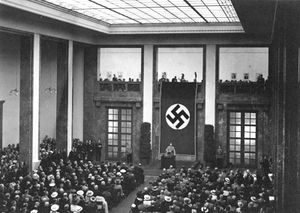
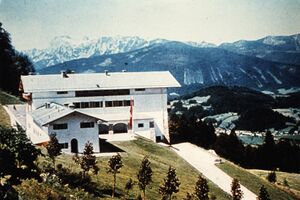
Hitler awarded Munich the title "Hauptstadt der Bewegung" (The Capital of the Movement) on 2 August 1935. Here he himself held the function of a party representative as provided for in the Deutsche Gemeindeordnung (German Municipal Code). Munich's importance as a city of art was accentuated by the building of the "Haus der Deutschen Kunst" (House of German Art) opened on 18 July 1937. The most spectacular annual mass events, which required a huge amount of organisational and financial effort, were the Reichsparteitage (Reich Party Rallies) in Nuremberg. The local Reichsparteitagsgelände (Reich Party Rally Grounds) were probably the largest construction site in Europe up to 1939, when work had to be stopped. The rebuilt Luitpoldarena and the parade area on the Zeppelinfeld (Zeppelin Field) were completed; the Congress Hall was very advanced. Party rallies were held regularly between 1933 and 1938 on the grounds of the Zeppelinfeld, which had a capacity of 250,000 people and was surrounded by stone grandstands, against the backdrop of the party's monumental buildings. In addition to Munich and Nuremberg, another place in Bavaria was also of outstanding importance because of Hitler's presence: Hitler had rented "Haus Wachenfeld" (“Wachenfeld House”) on Obersalzberg mountain since 1928, which he then purchased after the "seizure of power" and had converted into the large-scale "Berghof" residence from 1935 on. At times, this was de facto his second seat of government, where he received high officials, party leaders, military officers, but also foreign guests of state and other celebrities. Munich lost its appeal compared to Berlin and Obersalzberg. The regime also had the opportunity to present itself internationally through the 1936 Olympics. The Winter Games were held in Garmisch-Partenkirchen in Bavaria from 6 to 16 February. A large KdF hall was built for this next to the town hall, along with a festival hall building, ski stadium, artificial ice stadium and large ski jump.
Membership Development after 1933
In 1935 the party had 281,806 members in Bavaria, 58,677 in Munich-Upper Bavaria, 75,165 in the Bayerische Ostmark, 38,021 in Franconia, 39,002 in Main-Franconia, 35,213 in the Palatinate, 35,728 in Swabia and 2,493,890 in the Reich. Bavaria therefore provided 11.3% of the membership in the Reich. Since the "seizure of power" the number of members had more than trebled and had risen more than the Reich average. 5.6% of the eligible voters in Bavaria belonged to the party. The proportion of the middle-class had increased compared to 1933, while that of the working class had remained the same. 32.1% of the members were blue-collar workers, 14.6% white-collar workers, 19.5% self-employed, 12.8% (26%) civil servants and 13.1% farmers. The share of members aged 20 to 30 was now 35.3% (Reich 34.1%). (As of: 1 January 1935) On 19 April 1933, Reichsschatzmeister Schwarz announced a ban on admissions that would take effect on 1 May. The number of opportunists, but also the number of civil servants that flooded into the party due to pressure, threatened to become too large. Moreover, the Gauleiters had bypassed Schwarz in admitting applicants and had not paid over their contributions. Nevertheless, the number of party members continued to increase, as the ban did not apply to members of subsidiary organisations such as the Schutzstaffel (SS – “Protection Squadron”), SA, HJ and the "Nationalsozialistische Betriebszellenorganisation". In May 1937 the ban was lifted again, mainly because of the party's great need for money. The pressure to join was now increased, especially on the civil service. The influx was large, but there are no precise statistics for Bavaria. In the Reich, the number of members rose from about 2.4 million at the beginning of May 1937 to 3.9 million at the end of 1938 and 8 million in 1945. From 1933 to 1935 the number of functionaries in Bavaria had increased by more than two and a half times, so once again it had not quite kept pace with the growth in membership. The number of Politische Leiters was now 53,014, representing 18.8% of the membership. The predominantly middle-class nature of the corps of functionaries remained. 27.8% of the Politische Leiters were aged between 21 and 30. Although this was a high proportion of young people, the position of the "old fighters" in the upper ranks of the party had become entrenched, blocking the advancement of younger members, especially at the level of Ortsgruppenleiters. In Munich-Upper Bavaria, 22.2% of the Politische Leiters who had been appointed before 1933 resigned by 1935, in the Bayerische Ostmark 13.1%, in Franconia 14.4%, in Main-Franconia 35.8%, in Swabia 10.6% and in the Palatinate 13%. In Swabia, 35.1% had been dismissed and 50.7% had left for professional reasons. The party's remit as a whole had changed after 1933. It was now no longer a political organisation fighting to gain power, but an instrument to maintain it through constant propaganda and by controlling the population.
The End of the Party
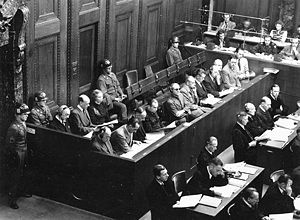
At the end of the war, the attitude of the Gauleiters and Kreisleiters was not uniform and ranged from fanatical doggedness to a willingness to surrender. The Allied Control Council Law No. 2 of 10 October 1945 banned and dissolved the party with all its branches and subsidiary organisations. The "Property Control Branch" of the US military government in Bavaria was responsible for the confiscation of the assets. Their Law No. 58 that came into force on 29 June 1947 transferred the party's assets located in Bavaria to the Bayerische Landesamt für Vermögensverwaltung und Wiedergutmachung (Bavarian State Office for Asset Management and Restitution). The Agreement for the prosecution and punishment of the major war criminals of the European Axis drawn up in London and issued on 8 August 1945 also contained the "Charter for the International Military Tribunal", which began its work at its seat in Berlin on 18 October 1945 and continued from 12 November 1945 on in Nuremberg, where an undestroyed large Palace of Justice still existed. With a continuation of the International Military Tribunal not to be expected after the end of the trial, the US military government decided to establish its most important military tribunals for the punishment of German war crimes in Nuremberg. 12 trials in total were conducted between 9 December 1946 to 11 April 1949. The military tribunal of the US Third Army was established at the former SS camp in Dachau and was to try members of the "Waffen-SS" (Armed SS) and the NSDAP suspected of war crimes. The actual Dachau trials began on 15 November 1945 with proceedings against members of the command staff of Dachau concentration camp. 28 people were sentenced to death and executed on 28 and 29 May 1946 in the "War Criminal Prison No. 1" in Landsberg am Lech. In addition to the proceedings for crimes committed in concentration camps, the "Malmedy Trial" against 74 members of the "Leibstandarte-SS-Adolf-Hitler" for shooting prisoners of war during the "Ardennes Offensive" took place in Dachau, as well as the trials for the murder of American airmen by German civilians when they had to make an emergency landing. The denazification of the population was carried out in Bavaria from 1945 to 31 December 1949.
References
- Shlomo Aronson, Reinhard Heydrich und die Frühgeschichte von Gestapo und SD (Studien zur Zeitgeschichte 2), Stuttgart 1971.
- Albrecht Bald, "Braun schimmert die Grenze und treu steht die Mark!". Der NS-Gau Bayerische Ostmark/Bayreuth: Grenzgau, Grenzlandideologie und wirtschaftliche Problemregion (Bayreuther Rekonstruktionen 2), Bayreuth 2014.
- Richard Bauer (Hg.), München - "Hauptstadt der Bewegung". Bayerns Metropole und der Nationalsozialismus, Ausstellungskatatalog, München 1993.
- Martin Broszat u. a. (Hg.), Bayern in der NS-Zeit. 6 Bände, München/Wien 1977-1983.
- Ulrich Chaussy/Christoph Püschner, Nachbar Hitler. Führerkult und Heimatzerstörung am Obersalzberg, 3. Aufl., Berlin 2001.
- Ortwin Domröse, Der NS-Staat in Bayern von der Machtergreifung bis zum Röhm-Putsch (Miscellanea Bavarica Monacensia 47), München 1974.
- John Dornberg, Hitlers Marsch zur Feldherrnhalle. München, 8. und 9. November 1923, München/Wien 1983.
- Donald Morse Douglas, The early Ortsgruppen. The Development of National Socialist Local Groups. 1919-1923, Xerokopie von Mikrofilm, Diss. University of Kansas 1969.
- Carol J. Ehlers, Nuremberg, Julius Streicher and the Bourgeois Tradition to Nazism. 1918-1924, Xerokopie von Mikrofilm, Diss. University of Colorado 1965.
- Thomas Forstner, Die Beamten des bayerischen Innenministeriums im Dritten Reich. Loyale Gefolgsleute oder kritische Staatsdiener? (Forschungen zur Landes- und Regionalgeschichte 8), Sankt Ottilien 2002.
- Georg Franz-Willing, Krisenjahr der Hitlerbewegung 1923, Preußisch Oldendorf 1975. [indispensable because of the source material collected, even in the face of Franz-Willings connections to the right-wing extremist camp]
- Georg Franz-Willing, Putsch und Verbotszeit der Hitlerbewegung. November 1923-Februar 1925, Preußisch-Oldendorf 1977. [indispensable because of the source material collected, even in the face of Franz-Willings connections to the right-wing extremist camp]
- Georg Franz-Willing, Ursprung der Hitlerbewegung 1919-1922, Preußisch Oldendorf 2. Auflage 1974. [indispensable because of the source material collected, even in the face of Franz-Willings connections to the right-wing extremist camp]
- Harold J. Gordon jr., Hitlerputsch 1923. Machtkampf in Bayern 1923-1924, Frankfurt am Main 1971.
- Thomas Greif, Frankens braune Wallfahrt. Der Hesselberg im Dritten Reich (Mittelfränkische Studien, Bd. 18), Ansbach 2007.
- Stefanie Hajak/Jürgen Zarusky, München und der Nationalsozialismus. Menschen, Orte, Strukture, Berlin 2008.
- Rainer Hambrecht, Der Aufstieg der NSDAP in Mittel- und Oberfranken (1925-1933) (Nürnberger Werkstücke zur Stadt- und Landesgeschichte 17), Nürnberg 1976.
- Andreas Heusler, Das Braune Haus. Wie München zur 'Hauptstadt der Bewegung' wurde, München 2008.
- Andreas Stefan Hofmann, Oberfranken zur Zeit des Natinalsozialimsuns 1933 bis 1939. Eine Studie über Aufstieg, Machtergreifung und Herrschaftsorganisation der Nationalsozialisten im Norden Bayerns (Veröffentlichungen des Stadtarchivs Bamberg 34), Bamberg 2020.
- Hans Hubert Hofmann, Der Hitlerputsch. Krisenjahre deutscher Geschichte 1920-1924, München 1961.
- Kim R. Holmes, The NSDAP and the Crisis of Agrarian Conservatism in Lower Bavaria. National Socialism and the Peasant's Road to Modernity, New York u. a. 1991.
- David Jablonsky, The Nazi Party in Dissolution. Hitler and the Verbotzeit 1923-1925, London 1989.
- Ian Kershaw, Popular Opinion and Political Dissent in the Third Reich: Bavaria 1933-1945, Oxford 2. Auflage 1992.
- Manfred Kittel, Provinz zwischen Reich und Republik. Politische Mentalitäten in Deutschland und Frankreich 1918-1933/36 (Quellen und Darstellungen zur Zeitgeschichte 47), München 2000.
- Jochen Klenner, Verhältnis von Partei und Staat 1933-1945. Dargestellt am Beispiel Bayerns (Miscellanea Bavarica Monacensia 54), München 1974.
- Peter Kolb/Ernst-Günter Krenigh, Unterfränkische Geschichte. 5. Band, 1. Teil, Würzburg 2002.
- Marita Krauss (Hg.), Rechte Karrieren in München. Von der Weimarer Zeit bis in die Nachkriegsjahre, München 2010.
- Franz Kühnel, Hans Schemm. Gauleiter und Kultusminister (1891-1935) (Nürnberger Werkstücke zur Stadt- und Landesgeschichte 37), Nürnberg 1985.
- Iris Lauterbach/Julian Rosefeldt/Piero Steinle (Hg.), Bürokratie und Kult. Das Parteizentrum der NSDAP am Königplatz und München. Geschichte und Rezeption (Veröffentlichungen des Zentralinstituts für Kunstgeschichte in München, X), München/Berlin 1995.
- Werner Maser, Der Sturm auf die Republik. Frühgeschichte der NSDAP, Stuttgart 1973.
- Susanne Meinl/Bodo Hechelhammer, Geheimobjekt Pullach. Von der NS-Mustersiedlung zur Zentrale des BND, Berlin 2014.
- Rolf B. Memminger, The Bavarian Governmental District Unterfranken and the City Burgstadt 1922-1939. A Study of the National Socialist Movement and Party-State Affairs, Nebraska 1974.
- Horst Möller/Andreas Wirsching/Walter Ziegler (Hg.), Nationalsozialismus in der Region (Sondernummer der Schriftenreihe der Vierteljahrshefte für Zeitgeschichte), München 1996.
- Winfried Nerdinger (Hg.), München und der Nationalsozialismus. Katalog des NS-Dokumentationszentrums München, München 2015.
- Edward N. Peterson, The Limits of Hitler's Power, Princeton/New Jersey 1969.
- Geoffrey Pridham, Hitler's Rise to Power. The Nazi Movement in Bavaria 1923-33, London 1973.
- Othmar Plöckinger, Unter Soldaten und Agitatoren. Hitlers prägende Jahre im deutschen Militär 1918-1920, Paderborn 2013.
- Robert Probst, Die NSDAP im Bayerischen Landtag 1924-1933 (Münchner Studien zur neueren und neuesten Geschichte 19), Frankfurt am Main u. a. 1999.
- Mathias Rösch, Die Münchner NSDAP 1925-1933. Eine Untersuchung zur inneren Struktur der NSDAP in der Weimarer Republik (Studien zur Zeitgeschichte 63), München 2002.
- Daniel Roos, Julius Streicher und "Der Stürmer" 1923-1945, Paderborn 2014.
- Claudia Roth, Parteikreis und Kreisleiter der NSDAP unter besonderer Berücksichtigung Bayerns (Schriftenreihe zur bayerischen Landesgeschichte 107), München 1997.
- Michael Ruck, Bibliographie zum Nationalsozialismus. 2 Bände, Darmstadt 2000. [grundlegendes bibliographisches Hilfsmittel]
- Hermann Rumschöttel/Walter Ziegler (Hg.), Staat und Gaue in der NS-Zeit. Bayern 1933-1945 (Beihefte der Zeitschrift für bayerische Landesgeschichte B 21), München 2004.
- Wolfgang Schäfer, NSDAP. Entwicklung und Struktur einer Staatspartei des Dritten Reiches (Schriftenreihe des Instituts für wissenschaftliche Politik in Marburg/Lahn 3), Marburg 1956.
- Katja-Maria Wächter, Die Macht der Ohnmacht. Leben und Politik des Franz Xaver Ritter von Epp (1868-1946) (Europäische Hochschulschriften III/824), Frankfurt am Main u. a. 1999.
- Susanne Wanninger, "Herr Hitler, ich erkläre meine Bereitwilligkeit zur Mitarbeit." Rudolf Buttmann (1885-1947). Politiker und Bibliothekar zwischen bürgerlicher Tradition und Nationalsozialismus (Beiträge zum Buch- und Bibliothekswesen 59), Wiesbaden 2014.
- Falk Wiesemann, Die Vorgeschichte der nationalsozialistischen Machtübernahme in Bayern 1932/1933 (Beiträge zu einer historischen Strukturanalyse Bayerns im Industriezeitalter 12), Berlin 1975.
- Andreas Wirsching (Hg.), Nationalsozialismus in Bayerisch-Schwaben. Herrschaft-Verwaltung-Kultur (Augsburger Beiträge zur Landesgeschichte Bayerisch-Schwabens 9), Ostfildern 2004.
- Walter Ziegler, Bayern im NS-Staat 1933 bis 1945, in: Handbuch der bayerischen Geschichte. 4. Band, 1. Teil, München 2. Auflage 2003, 500-634.
- Zdenek Zofka, Die Ausbreitung auf dem Lande. Eine regionale Fallstudie zur politischen Einstellung der Landbevölkerung in der Zeit des Aufstiegs und der Machtergreifung der NSDAP 1928-1936 (Miscellanea Bavarica Monacensia 87), München 1979.
Sources
The most important source materials concerning the history of the NSDAP in Bavaria can be found in the Bundesarchiv (German Federal Archives) in Berlin and Koblenz (www.bundesarchiv.de/ https://www.bundesarchiv.de/EN/Navigation/Home/home.html), the Bayerisches Hauptstaatsarchiv (Bavarian Main State Archives) in Munich, the Staatsarchive (State Archives) in Munich, Amberg, Augsburg, Bamberg, Coburg, Landshut, Nuremberg and Würzburg (https://www.gda.bayern.de/generaldirektion/ ) and the Institut für Zeitgeschichte (Leibniz Institute of Contemporary History) in Munich (www.ifz-muenchen.de).
Of the printed sources and editions, only a few can be mentioned here:
- Adolf Hitler, Mein Kampf. 2 Bände, München 1925/1927.
- Akten der Parteikanzlei der NSDAP. Rekonstruktion eines verlorengegangenen Bestandes. Sammlung der in anderen Provenienzen überlieferten Korrespondenzen, Niederschriften von Besprechungen usw. mit dem Stellvertreter des Führers und mit seinem Stab, bzw. der Parteikanzlei, ihren Ämtern, Referaten, Unterabteilungen sowie mit Heß und Bormann persönlich, hg. v. Institut für Zeitgeschichte. 1. Teil, bearb. v. H. Heiber. 3 Bände, München/Wien 1983; 2. Teil, bearb. v. Peter Longerich. 3 Bände, München/Wien 1992.
- Anordnungen. Zusammenstellung aller bis zum 30.03.1937 erlassenen und noch gültigen Anordnungen des Stellvertreters des Führers, München 1937. (nur für den Dienstgebrauch)
- Der politische Soldat. Nachrichtenblatt der NSDAP, Gau Schwaben. Band 3-12, Augsburg 1936-1945.
- Der Traditionsgau. Die Gauleitung München-Oberbayern der NSDAP ordnet an, Jg. 1937-1944.
- Ernst Deuerlein (Hg.), Der Hitler-Putsch. Bayerische Dokumente zum 8./9. November 1923 (Quellen und Darstellungen zur Zeitgeschichte 9), Stuttgart 1962.
- Max Domarus, Hitlers Reden und Proklamationen 1932-1945. Kommentiert von einem deutschen Zeitgenossen. 2 Bände, Würzburg 1962.
- Lothar Gruchmann/Reinhard Weber (Hg.), Der Hitler-Prozeß 1924. Wortlaut der Hauptverhandlung vor dem Volksgericht München I. 4 Bände, München 1997-1999.
- Institut für Zeitgeschichte (Hg.), Hitler. Reden, Schriften, Anordnungen. Februar 1925 bis Januar 1933. 6 Bände, München 1992-2003.
- Eberhard Jäckel/Axel Kuhn (Hg.), Hitler. Sämtliche Aufzeichnungen 1905-1924 (Quellen und Darstellungen zur Zeitgeschichte 21), Stuttgart 1980.
- NSDAP-Partei-Statistik. 1.-4. Band [München 1935].
- Organisationsbuch der NSDAP, hg. vom Reichsorganisationsleiter, München 1. Auflage 1936, 7. Auflage 1943.
- Partei-Kanzlei (Hg.), Verfügungen/Anordnungen/Bekanntgaben, München 1942-1944.
- Reichsgesetzblatt, Berlin 1933-1945.
- Albrecht Tyrell (Hg.), Führer befiehl...Selbstzeugnisse aus der "Kampfzeit" der NSDAP. Dokumentation und Analyse, Düsseldorf 1969.
- Völkischer Beobachter, Münchner Ausgabe, 1933-1945.
Further Research
External Links
Related Articles
- Deutschvölkische Freiheitspartei (DVFP), 1922-1933
- Entnazifizierung
- Gauleiter
- Landtagswahlen (Weimarer Republik)
- Nationaldemokratische Partei Deutschlands (NPD), Landesverband Bayern
- Nationalsozialistischer Deutscher Arbeiterverein e.V. (NSDAV), 1920-1923/1925-1935
- Nationalsozialistischer Deutscher Studentenbund (NSDStB), 1926-1945
- Rechtsextremismus
- Schutzstaffel (SS), 1925-1945
- Stoßtrupp Hitler, 1923
- Sturmabteilung (SA), 1921-1923/1925-1945
- Traditionsgau München-Oberbayern, 1930-1945
- Völkischer Block in Bayern (VBl), 1924/25
Cite
Paul Hoser, Nationalsozialistische Deutsche Arbeiterpartei (NSDAP – National Socialist German Workers‘ Party), 1920-1923/1925-1945, published 12 February 2007, english version published 22 January 2024; in: Historisches Lexikon Bayerns, URL: <http://www.historisches-lexikon-bayerns.de/Lexikon/EN:Nationalsozialistische_Deutsche_Arbeiterpartei_(NSDAP-National_Socialist_German_Workers‘_Party),_1920-1923/1925-1945> (27.07.2024)

